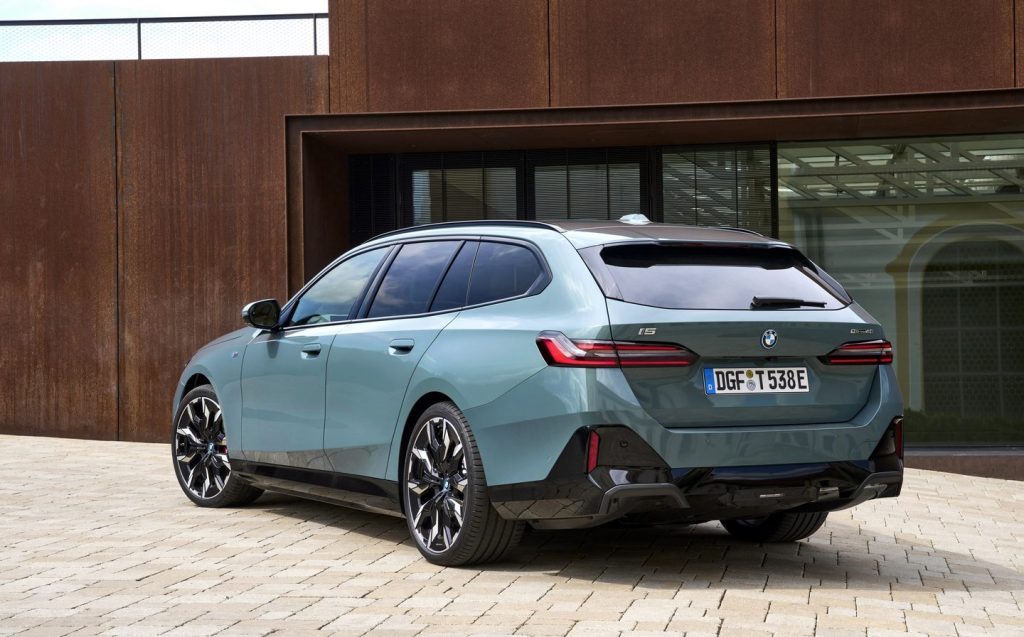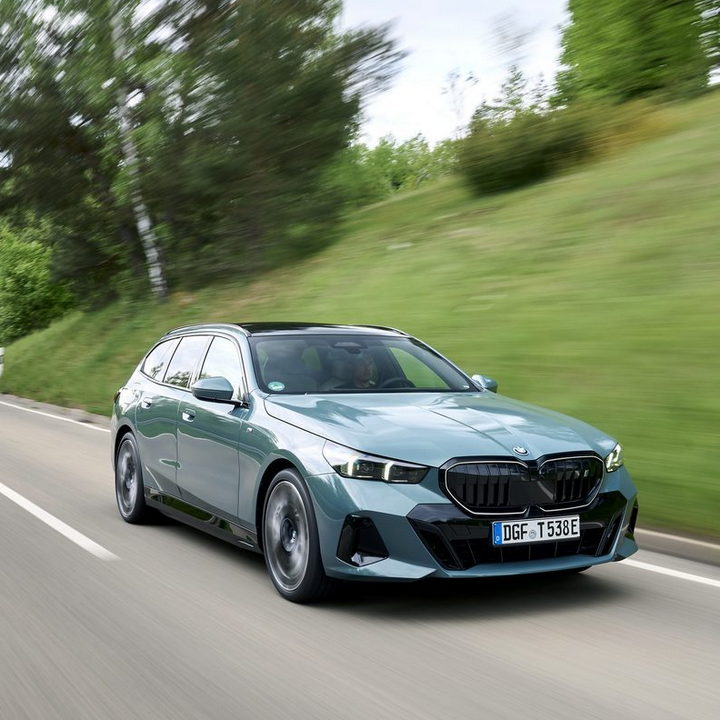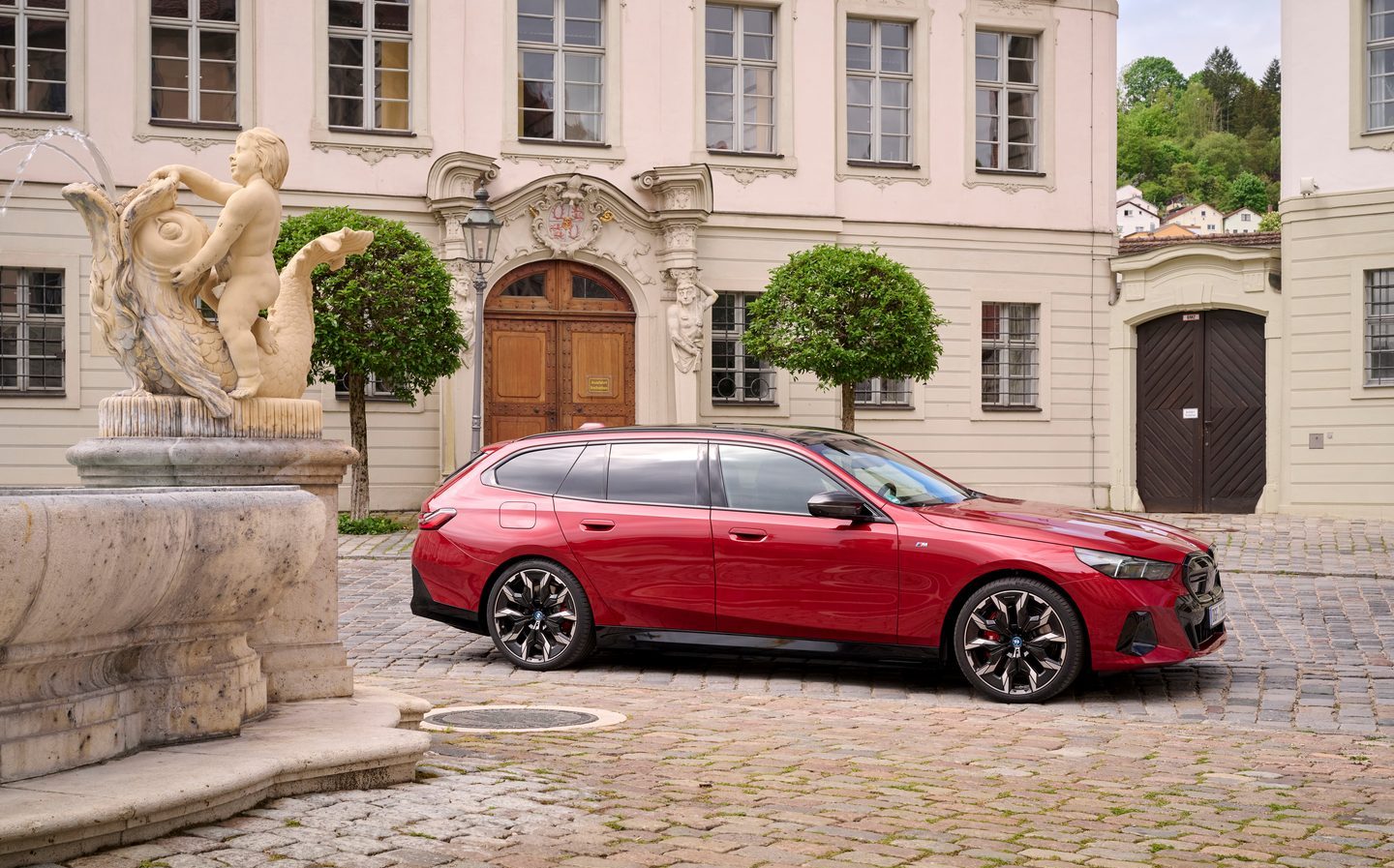BMW i5 Touring 2024 review: Quick, comfortable and desirable estate but motorways are its kryptonite
Non-electric 5 Series estates also available
BMW only started making estate versions of its 5 Series in 1991 but since then it has managed to shift more than a million of them around the world. Even in these SUV-addled times, thankfully the Touring remains a strong seller — especially in Germany where it usually out-does the saloon for signatures on dotted lines.
It’s never been too hard to see why. Buying a Touring means getting all of the attributes of the regular 5 Series saloon (handsome lines, a high-quality cabin, pin-sharp driving responses and serious performance from the bigger-engined versions) but with space for a Labrador and extra holiday luggage.
Has that recipe changed with the new, and now pure-electric i5 Touring? Not really, although there are some things of which we must take account.

Obviously, the new Touring is based on the saloon, and specifically here we mean the i5 electric saloon. There will be 520i petrol and 530e plug-in hybrid versions of the new Touring, too, but for now BMW is showing off its latest estate only with battery power.
For now that means a choice between the rear-drive, 335bhp single-motor eDrive40 and four-wheel-drive 593bhp dual-motor M60 models, both sharing the same external dimensions as the saloon in terms of length and width and height, and both also sharing the same battery pack (with a capacity of 81.3kWh).
But in terms of practicality, the i5 Touring marks a significant improvement over the saloon. From the four-door’s 490-litre boot, the Touring expands to a much more useful 570 litres (a volume retained by the plug-in hybrid model, impressively) and that expands to a long, flat, 1,700-litre load area if you tug the handles in the boot which topple the back seats forward.
There’s a neat underfloor storage area for charging cables and the luggage cover, too. Has BMW thought of everything, usefulness-wise, for the i5 Touring?

Ah, not quite. There is a significant omission. This is the first 5 Series Touring not to have a separate opening glass panel in the tailgate. That seems like a small thing, but the old flip-up rear screen was an always-handy, always-characterful addition and it’s a shame it’s not been kept. There are valid reasons, according to BMW, though we’re not sure we buy the claims that removing it improves aerodynamics, increases boot space and affords better rearward visibility, and the absence of this functionality made my bottom lip poke out a bit.
The rest of the cabin, aside from a touch more airiness in the back seats, is as per the saloon — beautifully made, roomy, exceptionally comfortable, but with an aesthetic that won’t please all (that odd plastic “crystal” light bar that runs across the dash, for instance).

The big sweeping curved screen on the dashboard is also only about 90 per cent pleasing. Yes, please, to the sharp graphics, responsiveness and general air of upmarket tech, but no, thanks ,to an occasionally labyrinthine menu layout that has the driver attention monitor bonging at you as you ponder which part of the screen to stab next.
Synthetic leather is standard on the i5 (isn’t that just plastic really, BMW?), but our test cars came with up-specced Merino leather, and call me old-fashioned but the cabin looked and smelt classier as a result.
Would you call the outside classy? Many people wouldn’t (in fact one internet interlocutor reckoned that Stevie Wonder was running the BMW design department) but for what it’s worth, I think it rather handsome, especially in the blood-red paint and contrasting carbon-fibre trim of the M60 version. I’ve even grown quite fond of the blanked-off grille (shades of 1970s Aston Martin Vantage, just a little?) and its cheesy surround-lighting. Each to their own.

Unsurprisingly, the idea of a practical family-friendly estate car with nearly 600bhp is one that gets us feeling all tingly inside, but what’s most enticing about the M60 i5 Touring in the first few moments is just how refined and comfortable it is.
Even on the massive 21in alloy wheels, this is a car that treads incredibly lightly — which is doubly impressive when you clock the 2,300kg kerb weight. Speed bumps, rippled tarmac and country roads; the M60 just shrugs them off with an effortless shimmy of the shoulders. It’s a delightful car in which to merely roll along.
However, for your £99,995 and given that M badge (even if it is a “mere” M Performance vehicle, and not a full-fat BMW M car), you’ll be expecting more than just medium-speed rolling refinement. And you can have it. You can tug the “Boost” paddle that nestles behind the left-hand spoke of the flat-bottomed steering wheel, which gives you instant access — for ten seconds, complete with on-screen countdown — to even more performance and a 0-62mph time of just 3.8 seconds.

Now, there are a couple of things to remember about this. One is that if you really want an electric car to show off at the local traffic light grands prix, you can do so for considerably less than the pricetag of this i5 M60 by shopping in your nearest Chinese car dealer. Two is that, after a couple of goes, you’ll never do it again. It really is quite unsettling to accelerate like that from a standing start, and your family (and pets) will likely not tolerate it much.
However, the i5 M60 has a clear advantage over its less expensive competitors when it comes to handling a curvy road. A BYD Seal or MG4 X-Power may be quick on a straight stretch but they’re not very good when the road bends. The i5 M60 Touring is.
That doesn’t mean it feels like a genuine M-machine. The weight takes a toll, especially in tighter corners where the front end is slow to respond. But on wider, faster corners the M60 rules. In the electric-car world, only a Porsche Taycan can match it, and the Taycan can’t carry 570 litres of luggage.

The thing is that the cheaper, slower eDrive40 version of the i5 Touring is slightly sweeter to drive. It certainly suffers less (if not quite none) of the M60’s nose-heaviness and shares its sweet steering weight (not much actual feel, though) and fine poise, not to mention the same ride comfort and sepulchre-like refinement at a cruise.
It’ll also go further on a charge. Hang on (rustles through notes), maybe it won’t. BMW’s long-standing decision to develop its electric cars using the same core underpinnings and bodies as its petrol cars has paid dividends. The i5 Touring has, after all, arrived onto the market well ahead of the rival Audi A6 e-tron Avant and Mercedes isn’t even bothering with an EQE estate, depending instead on the lumpy-looking EQE SUV.
However, there does seem to be a price to pay for that lack of electric-only focus and it’s the range per top-up.

Which is not to say that the i5 Touring lacks for range, or at least not quite. It’s just… variable. In mixed driving, in and around Munich, on country and town roads, and with a quick blast up the A9 Autobahn to see just how quickly the M60 can get well into three-figure speeds (quick enough to give you a dose of the giggles as it turns out), both versions seemed to offer similar enough range on one charge.
That’s give-or-take 310 miles for the eDrive40 and around 280 miles for the M60, both figures close enough to their official numbers of 342 miles and 310 miles, respectively. Indeed, the eDrive40 averaged a creditable 3.5 miles per kWh on that route.
The problems arose when we tried to take the same eDrive40 version of the i5 Touring on a longer journey. A properly longer journey: 750 miles from Munich to Cherbourg, as it happens. On those long runs along French Autoroutes (where 80mph is nice and legal) the i5 Touring needed recharging slightly too often.
An overall energy consumption figure that dipped just below the 3.0 miles per kWh figure isn’t too bad, but we still needed to undertake the journey in a series of 120-150-mile stints between charging points.

Now, in fairness, this wasn’t much of a hardship as the French charging network is incredibly good (300kW rapid chargers, and lots of them, at frequent motorway intervals) and the BMW charging card got each and every one of them to work each and every time. Thank goodness, as rapid charging has become very expensive.
The maximum DC rapid charging speed in the i5 is 205kW, and we repeatedly saw that in action (you can optionally have AC charging at up to 22kW). It’s not even that the i5 Touring is especially short on range, it’s just that we can’t help but feel even another 30 miles would make an enormous difference to such trips. A Hyundai Ioniq 6 has longer legs and so would be a more agreeable motorway friend.
Aside from that, though, the i5 Touring excelled in every aspect of this trip from the Alps to the Channel. It offered outstanding comfort and quietness, plenty of room for baggage, and a fun drive on the smaller, more scenic roads in Normandy. It also gave the satisfaction of driving a spacious car that’s not an SUV. The only thing that could have improved the journey was having fewer charging stops along the way. But for those not needing to cross full countries in one go, it should be perfectly acceptable.
Related articles
- If you found our review of the BMW i5 Touring interesting, you might want to read our review of the BMW i5 saloon
- You might also like to read our review of the BMW M3 Touring
- Or, check out the best luxury cars to buy
Latest articles
- F1 2025 calendar and race reports: The new Formula One season as it happens
- Seven great automotive events to visit this summer, from F1 to art and champagne
- Watch new Porsche 911 GT3 smash Nürburgring record for manual cars
- Skoda Elroq 2025 review: Czech carmaker can’t seem to miss with its electric family cars
- Five best electric cars to buy in 2025
- Should I buy a diesel car in 2025?
- Zeekr 7X AWD 2025 review: A fast, spacious and high tech premium SUV — but someone call the chassis chief
- Denza Z9GT 2025 review: Flawed but sleek 1,062bhp shooting brake from BYD’s luxury arm
- Extended test: 2024 Renault Scenic E-Tech review





























